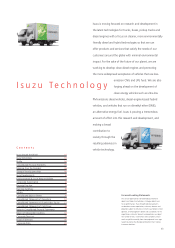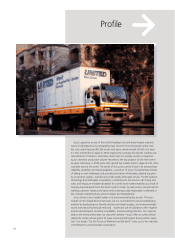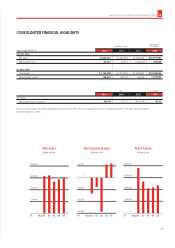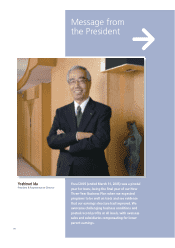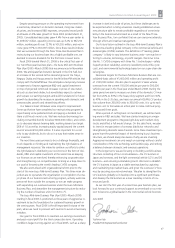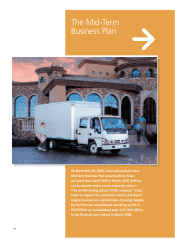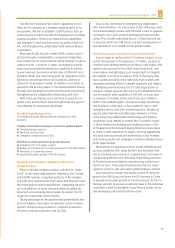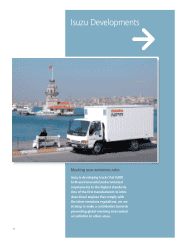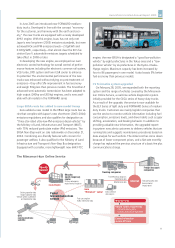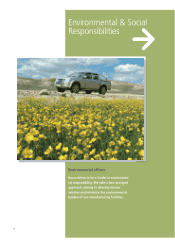Isuzu 2005 Annual Report Download - page 6
Download and view the complete annual report
Please find page 6 of the 2005 Isuzu annual report below. You can navigate through the pages in the report by either clicking on the pages listed below, or by using the keyword search tool below to find specific information within the annual report.
increase in steel and crude oil prices, but these challenges are to
be expected when running a business. Having established a busi-
ness structure able to remain profitable regardless of some insta-
bility in the business environment as a result of the New Three-
Year Business Plan, I am confident that we can overcome adversity
through effort and creative management.
Our Future Vision outlined in the Isuzu Mid-term Business Plan is
to become a leading global company in the commercial vehicle and
diesel engine (CV/DE) markets. The definition of “leading global
company” is likely to vary between business units—we may be re-
ferring to volume, technology, or profit margins. We strive to be
the No. 1 CV/DE company with three No. 1 technologies—safety
(superb product reliability), economy (excellent product life-cycle
cost), and environmental technology based on our super-clean die-
sel engines.
Numerical targets for the Isuzu Mid-term Business Plan are con-
solidated-basis sales of ¥1,600,000 million and operating profit
of ¥100,000 million. We also plan to expand CV sales volume
overseas from the current 150,000 vehicles per year to 300,000
vehicles per year in the fiscal year ended March 2008. During the
same period we aim to increase our share of the domestic CV mar-
ket from 26% to 30% in the heavy-duty segment and from 36%
to 40% in the 2–3t class, and raise our annual ASEAN LCV produc-
tion volume from 200,000 units to 300,000 units. It is up to each
business unit to formulate an action plan to make continual prog-
ress toward these goals.
After a period of cutting back on investment, we will be invest-
ing more in R&D and sales. We have started investing in a major
development program to integrate light-duty and medium-duty
trucks and effect a full model change. On the sales front, we plan
to invest in reorganization of overseas distributor networks and
strengthening domestic sales channels. Since these investment pro-
grams have the potential impact of transforming Isuzu’s business
structure, we should always be aware of why we are investing.
Aggressive investment can only weigh on earnings without careful
consideration of the role technology and facilities play, and striking
a balance between domestic and overseas operations.
In the longer term, we are focusing on building a solid business
structure consisting of four core businesses—the CV business in
Japan and overseas, and the light commercial vehicle (LCV) and DE
business—and ensuring sustainable growth. We look to establish
the CV business in Japan as a stable earnings base by capturing
and maintaining top market share, and grow the overseas CV busi-
ness by securing a sound volume base. We plan to strengthen the
LCV business globally so it develops into a significant profit base,
and develop the DE business as a new mainstay in terms of rev-
enue and profit.
As we start the first year of a new three-year business plan, we
look forward to your continued support as we embark on our mis-
sion to become a global leader in the commercial vehicle business.
June 2005
Yoshinori Ida,
Yoshinori Ida
President & Representative Director
Despite growing pressure on the operating environment from
a reactionary downturn in domestic demand, rising raw materi-
als prices, and increased R&D expenses, we posted record profit
at all levels on 4% sales growth in fiscal 2005 (ended March 31,
2005). Consolidated-basis sales grew 4.4% from a year earlier to
¥1,493,567 million, operating income was up 3.2% to ¥87,214
million, working profit rose 12.1% to ¥91,555 million, and net in-
come grew 9.7% to ¥60,037 million. Since these results indicate
that we succeeded through the New Three-Year Business Plan in
restructuring our business base into a highly profitable one, we
decided to resume dividends for the first time in seven terms.
Fiscal 2006 (ended March 31, 2006) is the critical first year of
our next three-year business plan—the Isuzu Mid-term Business
Plan (April 2005–March 2008) that we announced in November
2004. We anticipate flat domestic demand in the first half, but
an increase in the second half as demand grows in the Tokyo,
Nagoya, Osaka and Hyogo areas for low-NOx/low-PM vehicles that
comply with the NOx/PM law. We anticipate a temporary increase
in expenses to finance aggressive R&D and capital investment
on top of projected continued increases in prices of raw materi-
als such as steel and rubber, but nonetheless expect to achieve
and surpass our earnings targets and build foundations for future
growth by absorbing the increase in spending with domestic and
overseas sales growth and streamlining efforts.
Our balance sheet still leaves some scope for improvement.
Some say that we have completed our restructuring program by
repurchasing some preferred stock and paying a dividend, but
there is still much more to do. We have reduced borrowings (ex-
cluding convertible bonds) to below ¥400,000 million, and contin-
ue to decrease interest-bearing debt, working toward our target
DER of 1.0 as well as increasing equity capital beyond the current
level of around ¥160,000 million. It is also important for us not
only to pay dividends, but to do so in a way that makes sense to
our investors.
The next three years promise to be a challenge financially, and
much depends on finding and maintaining the right balance of
management resources. We intend to continue our efforts to strike
the right balance in distributing our net income in the form of divi-
dends, R&D and capital investment at the same time as keeping
our finances on an even keel, thereby enhancing corporate value
and strengthening our competitiveness to bring us a step closer to
our goal of becoming the world’s leading CV/DE company.
We also went ahead with organizational reform prior to the
start of the new Isuzu Mid-term Business Plan. The three main ob-
jectives are to rejuvenate the organization on completion of a ma-
jor phase of our business restructuring program, actively welcome
personnel from outside the company so we can make progress
with expanding our overseas business under the Isuzu Mid-term
Business Plan, and streamline the management structure by reduc-
ing the number of business units from 83 to 75.
The Isuzu Mid-term Business Plan (April 2005–March 2008)
starting in fiscal 2006 is positioned as three years of aggressive in-
vestment to lay the foundations for sustained business growth in
the coming years. Fiscal 2006 is the all-important first year of the
plan, when we need to proceed with caution to avoid unnecessary
mistakes.
Our goal for fiscal 2006 is to maintain our earnings momentum
and post record profit for the third consecutive term. Operating
conditions began turning against us in fiscal 2005, such as a sharp
«
Isuzu Motors Limited Annual Report 2005
07


